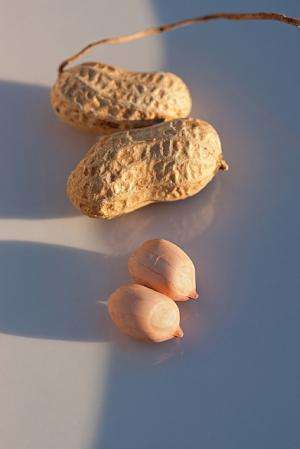A new Spanish peanut variety for consumers, growers

A new Spanish peanut variety that packs high levels of healthful oleic acid has been released by U.S. Department of Agriculture (USDA) scientists and university cooperators. The new variety, called OLé, could provide producers and consumers with a peanut that has disease resistance, longer shelf life and heart-healthy qualities.
Agricultural Research Service (ARS) biologist Kelly Chamberlin of the Wheat, Peanut, and Other Field Crops Research Unit in Stillwater, Oklahoma, and cooperators at Oklahoma State University developed OLé, which will be available for commercial production in 2015.
ARS is USDA's chief intramural scientific research agency.
Oleic acid is a beneficial monounsaturated fatty acid, and the high oleic acid levels in the peanut make its oil a heart-healthy one for consumers. Growers like the new variety because of its disease resistance and potential for high yield and grade.
According to Chamberlin, this is an important variety that will have a lot of impact on the peanut industry as a whole. Plus OLé has resistance to Sclerotinia blight, a fungal disease that can cause yield loss and is a particular problem for peanut growers in Oklahoma, Texas and the Virginia-North Carolina region. Depending upon severity of field infestation, yield losses due to such soilborne diseases may be as high as 50 percent.
Cultivated peanut is an economically important crop throughout the world. Peanut is susceptible to many pathogens, with most damage being caused by fungi. Soilborne fungi cause diseases that adversely affect peanut health and productivity throughout the growing areas of the United States.
Sustainable peanut production in the southwestern United States demands that cultivars grown there possess certain characteristics, including a high oleic/linoleic acid ratio, which increases peanut product shelf life, and resistance to multiple diseases, according to Chamberlin. In tests at three locations in Oklahoma, Chamberlin and her colleagues found that growing OLé reduced Sclerotinia blight infestation. This can save growers approximately $100 per acre in fungicide costs for Sclerotinia blight alone. The variety also has good pod rot resistance.
The first high-oleic Spanish peanut cultivar released, called OLin, was the result of collaborative efforts between Texas AgriLife Research, ARS, and Oklahoma State University. It was released in 2002. OLé produces higher peanut yields than OLin.
The OLé variety is now being grown for foundation seed before being made available commercially.

















